Prologue
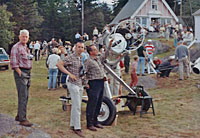
My first Stellafane Convention, in August 1966, was an experience so special to me that decades later, I still retain some very vivid memories of it—memories that include darker skies than I'd ever seen from my back yard at home, and an exquisite display of Perseid meteors, resplendent in the characteristic and incredibly beautiful "string of pearls" trails they left behind.
If you're a member of the "younger generation," or you're new to the Stellafane Convention, I'd like to share with you my memories of my first one (while I'm still able to do so!), in order to give you an appreciation of what it was like to be a first-timer in that era. Some things were pretty much the same as they are now. Others were very different.
If you're a member of the not-so-young Stellafane crowd, perhaps this narrative will bring back some pleasant memories. I certainly hope so.
This account is not intended to be a complete, formal history of the kind that Springfield Telescope Makers (STM) Club Historian, Museum Curator, and Archivist (and Russell Porter biographer2) Bert Willard writes. I didn't keep a formal journal or diary, so I worked mostly from memory, with an occasional reference to STM records and archives, personal e-mail communications, and live, in-person interviews.
To achieve maximum fidelity of my own recollections and distinguish them from material gleaned from other sources, I prepared the first few drafts without recourse to external sources. Where I’ve used such sources, they are carefully referenced in order to separate them from my own recollections.
I've also asked some key people, including some who were around at the time, to review and comment on this account. I alone, however, prepared the final draft, and must accept full responsibility for any inaccuracies. I certainly make no claim to perfect recall, but I really do think this is a reasonably accurate account.
Many of the names I'll be mentioning are those of persons who are now deceased, or believed by me to be so; some have not been around Stellafane for a long time, and their vital data are unknown to me. The few exceptions are (a) some I consider essential to the purpose of this account, and (b) some who have made profound, state-of-the-art-contributions to optics or astronomical observations (a la Russell W. Porter), or to the level of technology at Stellafane—and, happily, are still with us as of this writing.
How it all began. Events that led to my first Stellafane Convention
When I was only six years old and my younger brother, Peter, was a newborn, our family moved into a new (to us) home in southern New Jersey. Our parents had painted the ceiling of my bedroom a beautiful dark blue, and then applied some adhesive-backed luminous stars, configured as the Big Dipper. When that little six-year-old body in which I lived at time was reclined in bed at night, and the room lights were turned off, lo and behold—there was the Big Dipper, directly above!
I have no doubt whatsoever that that experience was what led me to look at the nighttime sky in search of the real Big Dipper, which, being rather bright, and circumpolar at my latitude, was easy to find. Following that came a lifelong interest in astronomy, and its most important tool—especially then—the optical telescope. Actually, my interest in telescopes–how they were built, and how they worked—often eclipsed (no pun intended) my interest in astronomy.
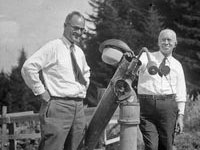
Now—fast-forward to junior high school, where the library collection included a book that totally captured my interest. It was about an inch or so thick, and its pages of very fine quality paper were cloth-bound under a maroon colored cover. It was a compilation of contributions by various authors. Its editor was Albert G. Ingalls of Scientific American magazine. Scientific American had published this book (at least, that's what the front cover said), and its chief contributor was a man named Russell W. Porter.
It was a gold mine of information about the astronomical telescopes of its time—how they were built, and how they functioned. I kept renewing the loan of this book so many times that the school librarian finally let me borrow it on an indefinite loan for the remainder of the school year, as long as nobody else asked to borrow it. Happily for me, nobody ever did!
That book, of course, was Amateur Telescope Making,3 now nostalgically referred to by the telescope making community simply as "ATM," or "ATM-1."
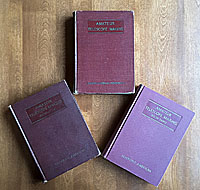
Please be advised that right here, and subsequently herein, I'm referring to the original series of Amateur Telescope Making books, first published under the Scientific American name3 by Munn & Company (first edition, 1926; the school library copy was a later edition). Many years later, these books were re-edited, reformatted, and republished by Willmann-Bell, under similar, but not perfectly identical, titles.4
Well, anyway, I devoured that book entitled Amateur Telescope Making! I read myself to sleep at night—night after night after night! I would later receive a copy of the third book in the series, entitled Amateur Telescope Making Book Three5 ("ATM-3") as a birthday gift from my parents, and as soon as I could scrape up the money, I got my own copies of ATM-1 and the second book in the series, entitled Amateur Telescope Making Advanced6 ("ATM-A").
Included in the front matter of my copy of ATM-1 was a photograph of an imposing clubhouse located atop a place called Breezy Hill, just outside the built-up area of Springfield, Vermont. I was really impressed! This remarkable place was called Stellafane, a contraction of the Latin Stellar Fane, which means "Shrine to the Stars." In the eaves of its roof was carved, in all uppercase letters, a passage from Psalm 19:1—"THE HEAVENS DECLARE THE GLORY OF GOD." Amateur astronomers and telescope makers met there periodically.
Now, fast-forward once again—this time, past high school and into the workaday world of 1966. At the time, I was employed as a long-distance telephone circuit troubleshooter for the old, legacy, pre-divestiture AT&T Company (Long Lines Department), while concurrently pursuing a college degree at night. In order to maintain the quality and continuity of long-distance telephone service, a certain minimum staffing level was required in the testroom at all times. The order in which we picked our vacation choices was based on seniority. All of the popular "prime" July vacation weeks were long gone, far out of the reach of this relative newcomer. I picked my first vacation week from an opening in August.
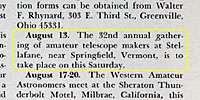
Only after the serendipitous choice of that August week did I see in Sky & Telescope magazine a small notice that the annual Stellafane Convention, sponsored by the Springfield Telescope Makers, assisted by the Amateur Telescope Makers of Boston, would be held on the Saturday of that very same week.
That's right—Saturday only! In those days, the convention, in addition to being very much smaller in terms of the number of attendees, was also only on that one day. Nevertheless, I just had to take advantage of the opportunity to see that hallowed place in the annals of amateur telescope making and astronomy. I planned to arrive early on the Friday before the convention, to allow plenty of time to get to know the lay of the land and find that place called Stellafane.
Getting there
There was no problem whatsoever in finding Springfield, Vermont, even in those days before GPS navigators. As I drove through town, I encountered a large banner hanging across Main Street, with all uppercase letters proclaiming “WELCOME TELESCOPE MAKERS.” It projected a very warm welcome indeed, but that feeling would soon yield to a bit of confusion and frustration!
Even though the formal convention date was not until the next day, I decided to try to find Stellafane late that Friday afternoon. I knew it was atop Breezy Hill, off Route 11, a few miles from the built-up area of Springfield. I turned off Route 11, onto Breezy Hill Road, and began my ascent. But there wasn't a trace of any road that led to the summit!
Nowadays, most of us arrive at Stellafane by climbing Breezy Hill Road to a spot not far from the point where it becomes a dirt road. We turn left onto Jordan Road, and a few hundred yards ahead lies what has come to be known as Stellafane East, and which is now the center of many Convention activities. But in those days, Stellafane East did not exist. It was the private property of an eccentric individual who reportedly had planned, in the event that the post-World War 2 Cold War ever became hot, to make his last stand on Breezy Hill. He actually built an above-ground bunker (now gone) on the property, which is presently owned by the Springfield Telescope Makers and is called Stellafane East.
But, enough of that. Jordan Road was not the objective. Stellafane was! I continued to the right along Breezy Hill Road, past Jordan Road. High in an old tree that had long since seen its best years, I saw an old "Stellafane" sign, with an arrow pointing to the right. I followed it and went onward toward what I thought must be some kind of access road to the summit, and Stellafane. Talk about utter frustration! I kept driving back and forth along Breezy Hill Road, and kept on winding up in built-up areas!
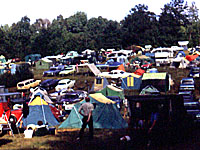
Miller property, 1974
Only after more than half an hour—maybe as long as 45 minutes—of that exercise did I decide to investigate what looked like a highly improbable cow path off of Breezy Hill Road. It was situated a short distance past today's left turn onto Jordan Road. It was little more than a pair of unpaved, unmarked tire tracks (now overgrown in the vicinity of, and no longer readily visible from, Breezy Hill Road). It was definitely a single car width only, but I ventured up anyway—and finally met with success! Activity! Human activity! Ahead there lay a meadow with a camping and parking area!
In those days before Stellafane East, the camping and day parking areas were one and the same, in that meadow, which was the property of the Miller Estate. It was rented annually by the Springfield Telescope Makers to facilitate parking and camping for Convention attendees—at their own risk, per a sign near the entrance. There was no registration, let alone preregistration, for a campsite. Just arrive, and if you wanted to camp, pitch your tent!
The former meadow of which I speak is located to the right as one traverses the present dirt access road (off Jordan Road) from Stellafane East toward the historic Pink Clubhouse. This former meadow subsequently became a Christmas tree farm, and is now overgrown with brush and trees. But in 1966, it was an open meadow and a hub of activity for Stellafaners. Its exit road, now also overgrown, lay parallel to, and only a few tens of feet to the right (again, when approaching from Stellafane East) of the present access road, which did not exist at that time.
Friday afternoon. First sighting
My odyssey had finally led to my intended destination. But I had yet to realize the final objective of my hundreds of miles of traveling. On foot, I started trekking up that final short road from the Miller property to the summit.
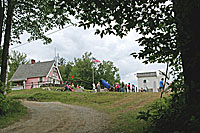
Suddenly—up and to the left–there it was! Stellafane! That hallowed spot of amateur telescope making! I paused for several seconds as my eyes drank in the scene of this very special place that had jumped out of the pages of ATM-1 and into my field of view. It was an unforgettable moment!
As I continued up, I saw more activity, and marveled at being a part of it. I also marveled at the wonderful things that were on display in the Pink Clubhouse. These included a lump of Pyrex from the first, unsuccessful Corning Glass Works (now Corning Incorporated) attempt at pouring the 200" blank for the primary mirror of the Hale Telescope atop Palomar Mountain in California. A large iron meteorite on the fireplace mantle was from Mexico. Among other things, I saw a multitude of photos of bygone days—photos of Ingalls, Porter, and other pioneering amateur telescope makers. There were photocopies of Russell Porter's portraits of the founders of the Springfield Telescope Makers, and photos of historic STM projects.
This first Pink Clubhouse experience was utterly fascinating, and things there remain pretty much the same today as they were half a century ago. The original old desk with its "donut-curve" drawer pulls still sits in the same corner in the front room, and the decor is about the same, and although the old cast-iron stove in the kitchen has since been replaced, its replacement is very similar.
Just north of "The Pink" was another Stellafane icon—the Porter Turret Telescope. This instrument is a reflecting version of, and was inspired by, the Hartness refracting turret telescope. The Hartness Turret Telesdope had been built, on the side lawn of his mansion, by former Vermont governor and Jones and Lamson Machine Company president James Hartness, for the 1910 apparition of Comet Halley. This historic instrument still sits outside the Hartness House Inn, in Springfield. Thanks to the Springfield Telescope Makers, it has been restored from a once very deteriorated condition, and is now functional.
At the time of my first Stellafane Convention, the Porter Turret Telescope was just under 36 years old. It had, I would learn, also undergone refurbishment by the Springfield Telescope Makers and would be available for viewing during the Convention. The upgrade had included replacing the original 16" plate glass optics with optics made from low-expansion materials. Ken Leathers, a friend of Stellafane, had made the new (12") parabolic primary.7 Present-day STM member, master optician, and MIT Lincoln Laboratory optical engineer Jim Daley8 had made the 16" optical flat used for aiming the instrument in declination. Daley is also a very highly respected authority on Schupmann telescopes. He has designed and built many telescopes of this type, and would go on to author a commercially published book9 about them, including their design and construction.
The Porter Turret Telescope, too, is very much the same today as it was in 1966, and has been well maintained by the Springfield Makers over the years. The interior of the observing enclosure has undergone a few convenience and decor upgrades. The old mechanical pocket watch that was once used for setting right ascension has been replaced by a modern electronic timepiece. But everything else is essentially the same.
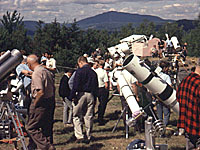
Roll-Off-Roof Observatory
at the 1966 Convention
On that day half a century ago, there was another observatory building (now gone) atop Breezy Hill, perhaps a hundred feet to the north and east of the Porter Turret. It was a small roll-off-roof observatory built by present-day STM member Bert Willard. It housed an 8" f/7.5 fork-mounted Newtonian reflector10 that he had completed in 1957, as a senior in high school, and it had taken first prize (mechanical) at that year’s Stellafane Convention. Bert subsequently removed this instrument to his residence, where he rebuilt it and sheltered it with a roll-off shed.
An observatory building that was not on Breezy Hill that day in 1966, but which is, as of this writing, under construction to the north and west of the Porter Turret Telescope, is to house the STM-restored Cook-Considine Spectrohelioscope, which hopefully will soon make its debut on "The Hill."
There were so many early arrivals for that 1966 Stellafane Convention, that in the judgment of those responsible for registering participants, they had better begin right away—on that pre-convention Friday evening—rather than wait until Saturday morning! That's right, Friday evening instead of Saturday morning! In those days, of course, there was no Internet-supported preregistration for participants. There were no Hartness House Workshops on the pre-convention Thursday. There were no open-forum style Friday evening talks, which are now held annually under the Flanders Pavilion at Stellafane East. Nor was there the big selection of additional family-oriented educational activities that have since become a regular part of the Stellafane Convention experience. The conventions of the 1960s really were a far more limited, one-day affair!
That “early” Friday registration took place in the Pink Clubhouse. The next morning, Saturday, the registration table was set up just outside the entrance to the Miller property, which entrance was at the foot of the final short stretch of dirt road that leads to the summit. This, of course, contrasts with the present registration and check-in location on Jordan Road, just outside Stellafane East.
Having been somewhat overwhelmed by this first exposure to Stellafane, I finally retreated to my motel room, eagerly anticipating the next day's activities.
Saturday morning
I returned to Stellafane early Saturday morning. But I did not head right to the swap tables, as so many of us do now on Saturday morning. I had a very good reason. There were no swap tables! The flea market-style swap tables would not make their debut until a number of years later, after a lot of discussion among the STM membership about whether, and to what extent, they might constitute a violation of the longstanding prohibition of commercial displays at the Stellafane Convention.
So, there being no swap tables, I headed right for the summit. I was in utter awe of what I saw! There were magnificent amateur-built telescopes all over the grounds in front of the Pink Clubhouse. One of them was a 20" trailer-mounted modified Cassegrain reflector, through which I would later—that evening—get a view of the Veil Nebula in Cygnus that is still as fresh in my mind as if it happened last night.
A telescope of that aperture was fairly unusual in those days. It had been built by one Roger W. Tuthill. Yes, that Roger W. Tuthill. Both of us were from New Jersey, he from the north and I from the south. We quickly became friends, and our friendship would last until Tut passed away, more than a decade prior to this writing. That part of the Stellafane experience—quick and lasting friendships— has not changed at all!
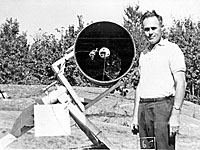
I asked Tut how he had made what was a relatively thin primary mirror for a 20" aperture. I was interested, of course, in how he minimized flexure during grinding, polishing, and figuring. Proper mounting would handle the problem while the mirror was in service, but fabricating it was another matter. So, then, how did he make that large, thin primary?
Tut gave his stock answer to the kind of question I had asked. With a bit of mischief in his facial expression, he looked at me and replied, “verrrrrrr-ry carefully!” He later did allow that he had tested its figure by autocollimation, using a water flat.
Tut and I would later (1973) travel together to Mauritania, in western Africa, to see the "solar eclipse of the millennium." It had approximately seven minutes and fifteen seconds of totality—only a few seconds shorter than the theoretical maximum.
It was during the preparations for that pioneering, 200-plus-member African eclipse expedition, led by Tut, that he got the inspiration for the full-aperture "Solar Skreen" aluminized Mylar solar filters that would become the mainstay of the astronomical accessories business he would later start. While investigating aluminized Mylar as a possible material from which to make tents that would keep out the strong Saharan sunlight, Tut noticed that the high reflectivity of the aluminum coating reduced the Sun's intensity, when viewed through the Mylar, to a level convenient for viewing with the unaided eye. The Sun's image appeared to suffer no distortion. After some technical investigation and some custom specifications, Solar Skreen was born. The Mylar was so thin that the wavefront distortion it introduced was minimal even if the filter material were not perfectly flat, as in a pellicle, over the full aperture of the telescope. It was just fine for all but the most critical applications.
(By the way, we ended up not using Mylar tents on the expedition. We stayed in a copper-mining area, under large, native-built tents, and some of us stayed in a permanent building there.)
Like so many of us, Tut really loved Stellafane. During one of my conversations with him over the years, he expressed a sentiment that others of us probably have today: He remarked that as a society, we have our civil calendar year, from the first of January through December 31st. Our government, and other organizations, have their fiscal years, e.g., from the first of October through the following September 30th. But he, Roger Tuthill, had what he referred to as the "Stellafane Year," from one Convention date to the next.
Tut also had a gift that most of us, including yours truly, do not have but would like to. After meeting a person just once, face to face—and learning that person's name—he could, for an indefinite time thereafter, remember that face and name. This ability doubtlessly served him well in both his personal and business affairs.
Back to my first Saturday morning at Stellafane: In addition to Tut's instrument and the other nighttime telescopes of various optical designs and mountings, there was a homebuilt solar telescope. It was equipped with a thin-film narrowband interference filter having a bandpass of approximately 2 angstroms (Å; 0.2 nm, SI11 ), centered on the hydrogen-alpha (Hα, Balmer) spectral emission line at 6562.8Å (656.28nm). When the bright, filtered image of the solar disk was blocked by this instrument's internal occulting disk, the result was an impressive view of solar prominences. It resembled a freeze-frame out of one of those vintage time-lapse black-and-white solar prominence movies I had seen on television as a young boy, and which, later experience had taught me, probably had originated at a solar observatory atop California's Mount Wilson. What a thrill to see a solar prominence—in its true, deep-red color—with my own eyes!
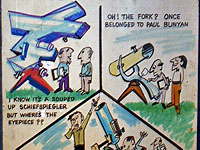
Situated among the astronomical instruments on display that day, near the front of the Pink Clubhouse, was a light-hearted cartoon (a "cartoon trilogy,” if you will) drawn by a man named Harry Kozan. He was, I believe, a professional cartoonist. If not, he was unquestionably skilled enough to be one. His annual contribution to the Stellafane experience was called The Tripod. The Tripod was drawn on a rectangular piece of poster board, itself mounted on an artist's "tripod" (easel). The drawing was divided into three sections by three lines emanating from the center of the poster board and separated by approximately 120 degrees. Each section had a standalone cartoon. [Stellafane's Harry Kozan Cartoon Collection]
One of those cartoons that I recall quite vividly, but possibly not from 1966, depicted a conversation between two obviously enthusiastic amateur astronomers. Their canine companion was underfoot, and had an equally enthusiastic expression, as only a skilled cartoonist could depict. One of the amateur astronomers said to the other, "His favorite object is the Dog Star."
These cartoon masterpieces are, according to STM Archivist Bert Willard, now preserved in the Stellafane archives.12
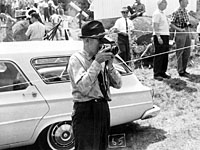
In addition to the instruments, there were the legendary people who were present that day in 1966. I've already mentioned Tut. Dr. Henry E. Paul was another. By profession, he was a pharmaceutical researcher. By avocation, he was a pioneering telescope maker extraordinaire, a very highly advanced amateur whose accomplishments, including making Schmidt cameras, are chronicled in the pages of ATM-3. He also independently authored several books on telescopes and astrophotography.13
Another legendary participant on that day half a century ago was Dr. B .L. "Ben" Souther, whose contribution on the subject of precise timekeeping of his era, and how to make a precision Synchronome clock for one's own use, is chronicled in ATM-A. The best possible timekeeping, and determination of precise time intervals have, of course, for centuries been of supreme importance to astronomers, navigators, and the scientific community in general. When Dr. Souther wrote his contribution, the type of clock he described was, he said, the most practical timekeeper for the best long-term accuracy (smallest "uncertainty" in the present-day jargon of the PTTI—precise time and time interval—community). Electronic clocks, based on crystal oscillators, were then in their infancy—laboratory curiosities of questionable long-term stability. And only in the imaginations of visionary physicists did any type of precision clock based on atomic resonance phenomena exist.
A clock built along Dr. Souther's guidelines, by a talented amateur named Dino Argentini,14 is presently on display in the Hartness-Porter Museum of Amateur Telescope Making, located at the Hartness House Inn in Springfield.
Still another legendary attendee that day in 1966, as I recall, was John Gregory, who originated the Gregory Maksutov-Cassegrain telescope design that became a staple of the product lines of some commercial telescope manufacturers.
Yet another legendary Stellafaner who was present that day was Ralph Dakin, after whom the renowned Dakin Barlow lens (negative achromat used for extension of primary effective focal length) is named. For you trivia buffs, he did not design the Dakin Barlow. He "discovered" it in a pile of discards (a production overrun15) at the company for which he worked at the time. He thought it had promise as a Barlow lens, and gave it a try. The rest is history.
Also there that day, as I recall, was Stanley W. Brower, who is not as widely known among present-day amateurs. He had his own optical company and like many professionals, also had the amateur’s passion.
Over the years, many "living legends" from the world of astronomy and telescope making would make an appearance on Breezy Hill. I'll mention another very early one (very early to me, at least). He was Dr. J. Allen Hynek, an astronomer and college professor, and a lightning rod of the UFO (unidentified flying object) controversy of that era. I distinctly remember seeing Dr. Hynek on Breezy Hill, and confirming his identity by the name tag he was wearing. However, I wouldn't testify in a court of law that it positively was in 1966; it may have been just a wee bit later.
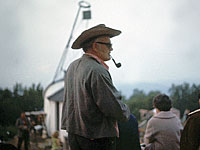
But possibly the most widely recognized personality who very definitely was present on Breezy Hill that day half a century ago was a man wearing a droopy hat and sporting an equally droopy smoking pipe, the curved stem of which seemed always to be hanging from between his front teeth, sometimes even when he was talking. I refer, of course, to none other than the renowned Walter Scott Houston—"Scotty" to his friends, and to his family, "The Old Man." That nickname was given to him by his family as a mark of profound respect of the kind still found in some cultures even today—cultures in which advanced age is equated to great wisdom.
I could hardly believe I had the opportunity to meet and talk at length with this icon of amateur astronomy and journalism. He would go on for nearly half a century to write his monthly Deep-Sky Wonders column in Sky & Telescope magazine. As an author, he used his middle name, rather than simply "Walter Houston," in order to distinguish himself from a well-known contemporary actor named Walter Huston—the same surname and pronunciation as Scotty's, but with a slightly different spelling.
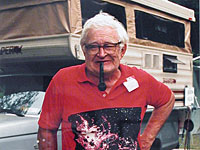
Scotty had a bit of an impish streak in him. For example, long before I met him (and unbeknownst to me at the tine I first met him) he had perpetrated an April Fool astronomical hoax (not in Sky & Telescope, I hasten to add). In another publication,16 he had "cited" a fictional professor, from a fictional institution of higher learning, as claiming that Mars' two recognized natural satellites were in fact artificial, having been constructed by some unknown, highly advanced civilization. Some people actually took the bait—hook, line, and sinker!
Impish or not, Scotty and I would go on to remain friends until he passed on in the early 1990s.
Noontime
So much for the morning's activities of that day half a century ago. If one were hungry for a bite to eat, it was available throughout the day from a vending station that was located immediately behind the Pink Clubhouse. This vending station was attended by members of the of the Springfield Hospital Auxiliary. All of them, as I recall, were women.
I know that today, that statement can evoke some rather strong emotions, and from more than one perspective. But that's the way it was, what it was, when it was. Most certainly, there is absolutely nothing demeaning about the volunteering of one's time and efforts (whether by women or by men) in support of fund-raising for a worthy cause. And I'm not gender-bashing, either. I know better. I've been privileged to be acquainted with, and even have as close friends, some incredibly talented, highly accomplished women. Today, happily, a woman is as likely to be a physician on staff at a hospital as she is a fund-raising volunteer.
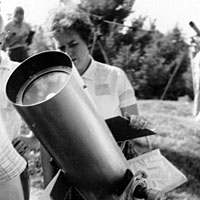
Among other things they can do very well—quite nicely, thank you—women can make telescopes, and good ones at that. There was one woman, Gladys A. Piper, in the first mirror-making class conducted by Russell Porter in October, 1920.17 Women have been STM members, officers (including president), and judges in the telescope competition (e.g., Virginia Day18), dating back many decades. And, may I add, women have been convention keynote speakers, too. From its very beginning, STM has been an equal opportunity organization! And attending that 1966 convention, as I recall, was telescope maker Diane Lucas.
After lunch, if it were necessary to relieve oneself, well, there was not the plethora of strategically placed, pleasantly deodorized, commercial port-a-potties on site, as there is now during the Stellafane Convention. Private matters were attended to in an outhouse located perhaps a hundred feet or so to the west of the Pink Clubhouse. On a hot day, one would ideally like to take a very deep breath, hold it, run in and take care business, and then run out as quickly as possible. It was a bit hard to handle!
Afternoon
There were Saturday afternoon technical talks ("tent talks") on that day half a century ago. They were held under a large rented tent that was pitched well behind (i.e., to the south of) the Pink Clubhouse, and used as an assembly venue. Speakers were there by invitation. One of the featured speakers that afternoon was the same Dino Argentini mentioned above. My recollection of him is that he (a) was of medium physical stature, (b) was a bright, talented man of very modest demeanor, and (c) had dark hair and a fairly large, dark, bushy mustache.
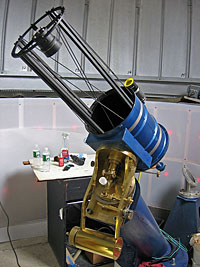
Argentini had made a beautiful brass diffraction-limited Ritchey-Chretien19 reflecting telescope, of 10" aperture and having a Springfield-style mount that facilitated a fixed eyepiece position. His only major machine tool was a small engine lathe of modest swing, about nine inches; it had perhaps a four-foot bed.
Argentini even used this lathe to hob out his own worm gear for the right ascension drive. To do this, he mounted an ordinary thread tap between lathe centers (headstock chuck and tailstock center). He had already prefabricated a circular gear blank with a central hole. He mounted this blank horizontally on the cross slide of the lathe carriage, from which the rest of the usual tooling (tool post, etc.) had been removed and replaced with a special jig that he had rigged up for the task. This was done in such a fashion that the gear blank (a) was held in place quite rigidly; (b) was positioned so that half its thickness lay parallel to and above the axis of rotation of the tap, and half, below; and (c) could rotate freely.
With the lathe carriage locked in place, he fed the cross slide, with gear blank in place, gradually inward, toward the slowly rotating tap. This rotation may have been accomplished (a) manually only, (b) powered but at a very slow, geared-down speed, or (c) a combination of both, which seems most likely to me; I'm not absolutely sure, so long after the fact. I do know that it successfully hobbed out the worm gear. Very ingenious! It’s no wonder that this instrument and Dino Argentini's presentation were such a huge hit on that Saturday afternoon in 1966. This beautifully crafted telescope now resides in the Domed Observatory20 below the McGregor Observatory at Stellafane East, for all to enjoy.
Following the tent talks that day, there was a gathering, under the same tent, of a loosely knit special-interest group known as the Maksutov Club. This group was composed of individuals interested in the construction of Maksutov telescopes—the Gregory Maksutov-Cassegrain variant in particular. The Maksutov Club meeting was conducted by one Allan ("Mac") Mackintosh, who was quite a colorful character (and a somewhat outspoken one at that; he always spoke his mind, no matter what, or about whom).

As I would later learn during numerous conversations with him over the years, Mac had held a wide variety of jobs in various places around the world. Perhaps this explains the accent of his spoken English, which impressed me as being “sort of” English-Scottish, but seemingly flavored by his having lived in so many different places.
In one respect Mac had emulated Russell Porter and Oscar Marshall.21 His telescope making hobby had, he once told me, led to the offer (which he accepted) of a position as Observatory Engineer at Indiana University.
Upon retirement, Mac went to England to spend his remaining years. His only retirement ambition, he once said to me, was to be "a thorn in the side of my various pension plans." Another of his quotes that stuck with me over the years is: "The older I get, the more I like my bed."
On at least one occasion after retiring to England, Mac came back to attend the Stellafane Convention.
The Maksutov Club had come into being when amateurs interested in building John Gregory's Maksutov-Cassegrain design faced certain hurdles. One lay in obtaining the optical glass blanks needed for the first element, a very deeply curved meniscus correcting lens having a diameter nearly as great as that of the primary mirror. Purchased individually, these blanks were rather expensive. Bought in larger quantities, they were more affordable. Mackintosh facilitated that bulk purchase.
Another hurdle was the lack of literature about how to fabricate and test the optics of a Maksutov telescope. For any given size (aperture) telescope it is, of course, much more complicated, and requires far more skill and perseverance, to build a Maksutov than to build the corresponding Newtonian reflectors that most amateurs make. In that pre-Internet era, Mackintosh acted as a point of contact for the exchange of information among Maksutov enthusiasts. A major part of this task entailed preparing and distributing what were known as Maksutov Club Circulars. These included matter contributed by Maksutov Club members. Later, Mackintosh authored two books on telescope making,22 which books were compilations of material from the Maksutov Club Circulars.
That evening half a century ago, I would see some of these Maksutov telescopes in action. I remember one in particular that was built by a telescope maker who had a rare distinction. He was one of Mac's protégés, Dr. Ferdinand Barr, of Rome, NY. His rare distinction? The first telescope ever built by Dr. Barr, who was known to his friends simply as "Doc," was a Maksutov! The instrument he had on display that evening in 1966 would, according to STM Club records,23 go on the following year to take second prize for optical excellence.
Also during the afternoon on Saturday, the judges made their rounds to evaluate the instruments entered in the various competitions for ingenuity of design and excellence of construction.
Evening
Evening brought to the forefront my second major miscalculation of my first Stellafane trip, following my difficulty in finding the summit from Breezy Hill Road.
Having grown up at an altitude of only a few tens of feet above sea level, and never having spent much time in mountainous areas, I was not at all prepared for the wide disparity between the daytime and nighttime ambient temperatures that I would encounter—even at Stellafane's relatively modest elevation of just under 1300 feet. To achieve even a limited degree of comfort, I ultimately resorted to putting on every stitch of clothing I had brought with me that would cover my torso (including a lightweight plastic emergency raincoat, which I donned in an attempt to trap warm air around me).
As daylight faded into dusk, the convention populace gathered on the sloped lawn in front of the Pink Clubhouse for the evening program, which at that time was called Twilight Talks. Yes, the entire assembled crowd was on the lawn area of the Pink Clubhouse! The Stellafane Convention really was much smaller in those days!
A hinged, folding plywood panel, painted white, was unfolded and hung from the rear of the Porter Turret Telescope's observing enclosure, to serve as the screen upon which photographic slides were projected by a 35-mm film projector. In those days, of course, digital photography and projectors did not exist, with possible exceptions being in the imaginations of a few engineering visionaries.
I don't recall the names of the emcee or the speakers (or subjects) at that 1966 Stellafane Convention.24 But then, as now, there were preliminaries built into the program, in order to allow darkness to set in before the featured speakers presented their material.
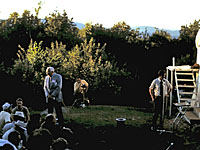
There was not the full range of preliminary activities that we now have in the Saturday Evening Program and Keynote Talk. For example, there was no fund-raising raffle (of donated prizes) for adults, and there was no free raffle for kids. But there was the annual appearance by Joseph B. "Joe" Johnson, a longtime member of the Springfield Telescope Makers25 and a former Vermont governor and state senator. Johnson always said a few words of welcome to the attendees, and 1966 was no exception. At the time, he was rather advanced in age. He took full advantage of the helping hands that were lifted up to assist him as he carefully made his way down from the front of the Pink Clubhouse, through a narrow pathway in the crowd, to the speakers' area at the rear of the Porter Turret Telescope.
In his political life, Johnson was a great supporter of education, including higher education. In his personal life, he was fond of Stellafane and the Stellafane Convention, and he graced it annually with his presence.
Also during the evening preliminaries, the judges' results from the mechanical competitions that afternoon were announced, and illustrated by 35-mm film slides that had been hastily developed and mounted for the occasion. The optical competition had yet to begin.
Another highlight of the evening preliminaries of that 1966 Convention was a regularly scheduled talk entitled Stellafane Lore. This annual talk was presented by John C. Pierce, a local school teacher. He was also the son of John M. Pierce, who was a founding member of the Springfield Telescope Makers and a contributing author of the first edition of ATM-1.
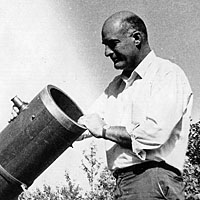
Stellafane Lore offered insights into the very earliest years of the Stellafane Convention—much earlier than the 1960s. There is one item I remember vividly from Stellafane Lore, possibly not from 1966 but very definitely not much later. This was the way John C. commended the then-contemporary telescope makers on the sizes (apertures) and varieties of the instruments entered in the competitions. In what were then the "old days," he noted—with a droning voice of lament that was modulated, more or less syllable by syllable, from low-pitched to high-pitched—the winner of the telescope competition would be the entrant who could build the best "six, inch, F/, 8, New, tonian, reflector."
The annual Stellafane Lore talks continued for only a short time after 1966. Sadly, John C. was, at a rather young age, suddenly and unexpectedly stricken ill, and passed away.
For a number of years following the loss of John C. Pierce, Scotty Houston took over the Stellafane Lore part of the evening program. Feeling that he could never do justice to the title "Stellafane Lore," at the suggestion of STM member Alan Rohwer,26 he called his talks Stellafane Shadowgrams. This name, of course, came from the delicate shadows that are observed, and which must be properly interpreted, in the process of evaluating the figure of a parabolic mirror by means of the Foucault knife-edge test.
After we lost Scotty, David Levy filled the slot, retaining the "Stellafane Shadowgram" title, until he, too, was suddenly stricken ill and was unable to continue. This slot in the Saturday evening festivities has since been filled on an ad hoc basis.
After the Twilight Talks
Following the Twilight Talks was an evening of observing (an all-nighter, perhaps, for some!), and the optical judging.
At this point, before going any further, I'd like to digress and discuss the optical judging and judges. As it is today, in those days an award certificate from the Stellafane optical judging (or mechanical judging, for that matter) was a prized possession. If one had fabricated optics good enough to pass the scrutiny of the Stellafane judges, and these optics had exceeded the performance of optics made by other amateurs, it was a source of great personal satisfaction.
This is because of the superb qualifications of the Stellafane judges. With no intent whatsoever to slight anyone else who was a judge that evening in 1966 (and there were some extremely good ones), I'd like to cite just two individuals who were. They both emulated Russell Porter in the sense that they were "amateurs" only in the literal sense of the word—they "loved" the subjects of optics and telescope making. Ultimately, each would arrive at the very pinnacle of his profession. In alphabetical order of their respective surnames, these individuals are Paul Valleli and Bert Willard, both of whom are current STM members.
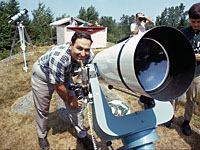
The career of Paul Valleli27 (judge in 1966), which would ultimately result in his becoming a world-class master optician, was composed of stints with numerous employers. Not all of the employment changes were voluntary, as companies or divisions thereof changed hands, and contracts dried up and layoffs took their tolls. Following is a very brief summary of his career highlights.
He started his career as a professional optician in 1957, under the tutelage of the late Robert E. Cox, of ADJ Optical Works, a small company of approximately 80 employees. Cox, among his other accomplishments, is better known among amateur telescope makers as the columnist who for decades wrote Gleanings for ATMs in Sky & Telescope magazine. At ADJ, he headed manufacturing research and development, and Valleli was his assistant, being assigned to the optical research lab. There, Valleli was trained in various aspects of generating, grinding, polishing, figuring and testing of optical surfaces, encompassing not only lenses and mirrors, but also crystals and semiconductors.
Valleli's tenure at ADJ lasted 2½ years, after which he joined Itek, followed by stints at Diffraction Limited, Inc., Ealing Corporation, Sanders Associates, Applied Optics Center Corporation (AOCC), Optical Systems & Technology, Inc. (OSTI), and a second stint at Itek.
Duting his career, among other things he worked on optics for (a) classified military applications; (b) NASA's Orbiting Astronomical Observatories; (c) Skylab (a U.S. precursor of the International Space Station); (d) Apollo 15, 16, and 17; and (e) Voyager 1 and Voyager 2, the enormously successful space probes to the outer reaches of the solar system. During his final stint at Itek, he had a supervisory role in the production of optics for a UV spectrograph used aboard the New Horizons spacecraft that probed Pluto.
During the course of his career he also managed to find tine to earn an Associate in Science (Mechanical Engineering) degree from Northeastern University and a B.S. in Industrial Technology (Fabrication Management), also from Northeastern. These were the culmination of years of study at different institutions of higher learning.
Valleli has been essentially retired from full-time work since the early 2000s, although as of this writing he has on tap one international consulting job. Since retirement, world-class master optician Paul Valleli has occupied his time with various optics-related projects and other, family-related, activities.
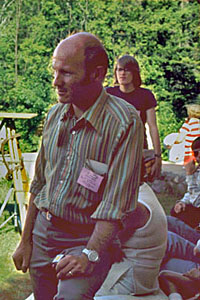
As noted earlier herein, Bert Willard28 (Judging Committee co-chair in 1966) had himself been an award-winning telescope maker as a youth just out of high school. Subsequent to that, he attended the Institute of Optics, University of Rochester, where he earned B.S. and M.S. degrees in Optical Engineering. The credentials of his professional career would go on to include participation, at MIT's Lincoln Laboratory, in the development of the first-ever adaptive optics technology, which mitigates the deleterious effects of atmospheric turbulence.
Now declassified and applied to large astronomical telescopes (including both those with monolithic primaries and segmented primaries), adaptive optics technology makes possible Earth-based telescopes with performance undreamed of by the founders of the Springfield Telescope Makers and the rest of the astronomical community of their day.
As of this writing, consummate professional optical engineer Bert Willard still works half time as a Staff Member at Lincoln Laboratory, where most of his professional accomplishments must still remain under wraps.
OK, now, back to the story. Shortly after the Twilight Talks were over, the judges made their rounds and performed their inspections of star images produced by the telescopes entered in the optical competition. Then they retreated to the Pink Clubhouse, which was temporarily off limits to everyone else. There, they deliberated and made their decisions. Late that night, when they were through, the results were announced over the public address system at the Pink Clubhouse. If award-winning contestants had retired for the evening and were thus not available to receive their certificates in person, they were mailed to them.
This is in contrast to the present procedure, which is to do the optical judging on Friday evening (weather permitting), with Saturday evening an option if needed. Mechanical judging is still performed on Saturday. All judging results, mechanical and (if available) optical, accompanied by digital photos of all award-winning instruments and the presentation of all award certificates, are now a part of the Saturday evening preliminaries.
One final event that took place that Saturday night in 1966 was the initial announcement of the date for the following year's Stellafane Convention. There was, of course, no Web site on which to post it, and unlike today, when convention dates are routinely published on the Stellafane Web site more than one year in advance, in 1966 only the date for the 1967 convention was announced. If you missed it, you waited to learn it from a pre-convention announcement sent by snail mail shortly before the event.
Epilouge
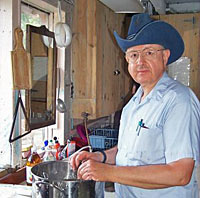
Well, there you have it. Full circle! My recollections and impressions of my first Stellafane Convention. I've attempted to paint a literary picture of what it was like to be a first-timer in 1966. I've tried to show the similarities and differences between then and now, and how the convention has grown and changed over the years. I do hope that you enjoyed it, and that the Stellafane Convention goes on for a minimum of at least another half-century!
Finally, I have one important caveat: Attendance at one's first Stellafane Convention can be habit-forming!
— References and Notes —
1. "Telescope Nut" ("T.N.") is the moniker that Albert G. Ingalls and Russell W. Porter applied to themselves, to each other, and to anyone else having a passionate interest in telescopes and telescope making.
2. Willard, Berton C., Russell W. Porter Arctic Explorer Artist Telescope Maker (ISBN 0-8702-168-7). Freeport, ME, The Bond Wheelwright Company, 1976
3. Ingalls, Albert G., Amateur Telescope Making. According to the Wikipedia history, the first three editions (1926, 1928 and 1933, respectively) were published by Scientific American. The fourth edition (1935) was published by Munn & Co., New York, New York. (There were twenty-four printings of this edition, the final one in 1980.) However, there seems to be a gap in the Wikipedia histories of (a) Scientific American and Munn & Co., and (b) the publication of the original ATM series. Less than a year after its founding in 1845, Scientific American was sold to a partnership that eventually became Munn & Co., early in the twentieth century, before 1926. According to the current Munn & Co. Web site, there is presently a “Scientific American Office” within that company.
4. Ingalls, Albert G.; (a), Amateur Telescope Making Volume 1 (ISBN 0-943396-48-4); (b), Amateur Telescope Making Volume 2 (ISBN 0-943396-49-2); and (c), Amateur Telescope Making Volume 3 (ISBN 0-943396-50-6). Richmond, VA, Willmann-Bell, 1996
5 Ingalls, Albert G., Amateur Telescope Making Book Three Scientific American, 1953. (The tenth and final printing of this edition was in 1979.)
6. Ingalls, Albert G., Amateur Telescope Making Advanced. Munn & Co., 1937. (The seventeenth and final printing of this edition was in 1978.)
7. Daley, James, personal interview, 2015 Stellafane Convention. Per an e-mail from Bert Willard (26 Auguat 2015), Ken Leathers, who was never an STM member, worked under Jim Daley at MIT Lincoln Laboratory, where at the time there was an optical shop. Both of the Porter Turret Telescope replacement mirrors were made in that shop. The 16" Pyrex blank Daley used for the new flat had been donated by Itek at the urging of Willard, who worked there at the time.
8. Willard, Berton C., personal interview, 2015 Stellafane Convention.
9. Daley, James, The Schupmenn Telescope The Story, Design, Construction and Use of a Neglected Telescope Type (ISBN 978-0-943396-59-0). Richmond, VA, Willmann-Bell, 2007
10. Willard, Berton C., Personal e-mail communication, September 16, 2014.
11. Système International d'Unités; International System of Units.
12. Willard, Berton C., Personal e-mail communication, September 16, 2014.
13. Paul, Henry E.,
(a) Binoculars and All Purpose Telescopes (ISBN 0-8174-3558-1). Amphoto, USA, 1983.
(b) Outer Space Photography for the Amateur (ISBN 0-8174-2407-5). Amphoto, USA, 1976.
(c) Telescopes for Skygazing (ISBN 0-8174-2408-3). Amphoto, USA, 1976.
14. In a great loss—not only to his family, but also to the entire ATM community—Dino Argentini (July 4, 1924-January 19, 2015) passed away in Danvers, MA, during the time interval over which this account was prepared. (Original notification from Paul A. Valleli, personal e-mail communication, March 19, 2015. Vital data from funeral home Web site)
15. Corroborated by Paul A. Valleli, Private e-mail communication, October 7, 2014.
16. The Great Plains Observer, April 1959. diCicco, Dennis, private e-mail communication, September 25, 2014.
17. STM Photo Archives, photo # STM0175.
18. STM Photo Archives, photo #STM0605.
19. Optical design confirmation and performance verification by Paul A. Valleli, personal e-mail communication, October 7, 2014.
20. During the time interval over which this account was prepared, the Springfield Telescope Makers approved a resolution to remove the Argentini instrument from the Domed Observatory and replace it with a remotely controlled instrument to better accommodate mobility-impaired observers. (Valleli, Paul A., personal e-mail communication, March 22, 2015.) Hopefully, Argentini’s instrument will eventually be on public view in the Hartness-Porter Museum of Amateur Telescope Making, if indeed another home is not found for it on Breezy Hill.
21. Oscar Marshall, STM member and master machinist, and Russell W. Porter were both hired by the California Institute of Technology to work on the 200-inch Hale Telescope project.
22. Mackintosh, Allan, Advanced Telescope Making Techniques Volume 1 Optics (ISBN 0-94339611-5) and Advanced Telescope Making Techniques Volume 2 Mechanical (ISBN 0-094339612-3). Richmond, VA, Willmann-Bell, 1986.
23. STM Convention Winners Page (https://stellafane.org/convention/historic/winners/winners.html).
24. Purposely, only after initially drafting this account did I consult the Stellafane archives for the 1966 program of
events* regarding the evening program (Twilight Talks). I had very vivid memories of the greeting from former Vermont
governor and state senator Joseph B. Johnson (and John C. Pierce as Stellafane Lore presenter).
However, I hadn't remembered the greeting from former U.S. Senator Ralph E. Flanders of Vermont (brother of STM
founding member E.V. "Ernie" Flanders and brother-in-law of Fran Flanders), who was also listed on the program.
And although I'd had vivid memories of seeing Stanley W. Brower and Dr. Henry E. Paul on "The Hill" during the
day, I did not remember them as featured speakers that evening, as listed in the program.
*https://stellafane.org/convention/historic/1966X/1966-program.pdf
25. STM Photo Archives, photo #STM0126.
26. Willard, Berton C., from his critique of the penultimate draft of this account.
27. Paul A. Valleli's biographical material is primarily from personal e-mail communications from him on October 2, 2014, March 24 2015, and April 1, 2015, and an in-person interview at the 2015 Stellafane Convention.
28. Berton C. Willard's biographical material is primarily from personal e-mail communications from him on September 9, 2014 and March 15, 2015.
— Acknowledgements —
1. It is with extreme gratitude that I acknowledge the invaluable assistance of the following individuals (in alphabetical order), who very graciously allowed me to "pick their brains" during the preparation of this account:
- Dennis diCicco, STM; former Senior Editor, Sky & Telescope magazine, and Scotty Houston’s editor for many years.
- James Daley, STM, master optician, and retired Optical Engineer, formerly with Lincoln Laboratory, Massachusetts Institute of Technology.
- Paul A. Valleli, STM; world-class master optician, now essentially retired. Paul also offered a plethora of historical facts; there were far too many to include herein, but they have been forwarded for inclusion in the STM archives.
- Berton C. Willard, STM; STM Archivist, Historian, and Museum Curator; author and presently a Staff Member (half-time) at Lincoln Laboratory, Massachusetts Institute of Technology. Bert also very graciously volunteered to review in its entirety, and comment on, the penultimate draft of this account. He offered many very helpful suggestions that resulted in a much improved, more accurate, final draft. Megathanks again, Bert, for keeping me on the straight and narrow!
2. Special thanks to STM Webmaster and current Vice President Ken Slater for his encouragement to go ahead and write this account, and for his indispensable assistance in getting it on line. In addition to performing the usual webmaster functions, he diligently searched STM archives and other STM sources for appropriate photographs to accompany the text. His contributions have made this account "come alive" for the reader.
3. Finally, I would be remiss indeed if I failed to acknowledge my brother, Peter W. Beaty, who has made it possible for me to attend very many Stellafane conventions I would otherwise have had to miss. This includes, but is certainly not limited to, the times he traveled from his home in Kentucky to southern New Jersey, to stay with our elderly mother, who was ordinarily under my care, so that I could be away for several days to attend the Stellafane Convention. Megathanks, Pete; you are the greatest! Megathanks also to Jean for being without her husband while he was away all those times.

